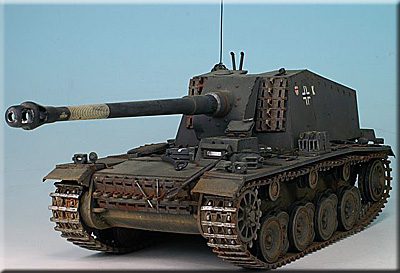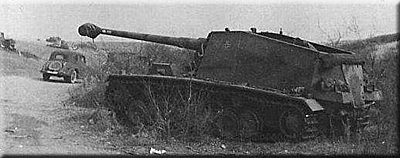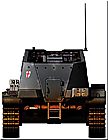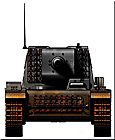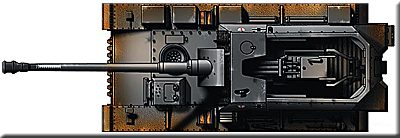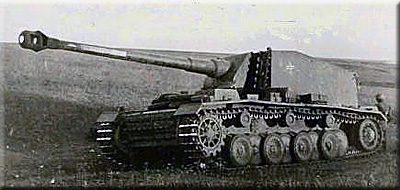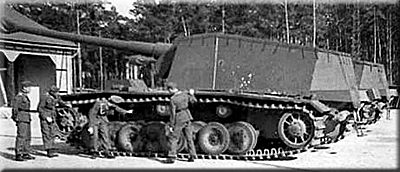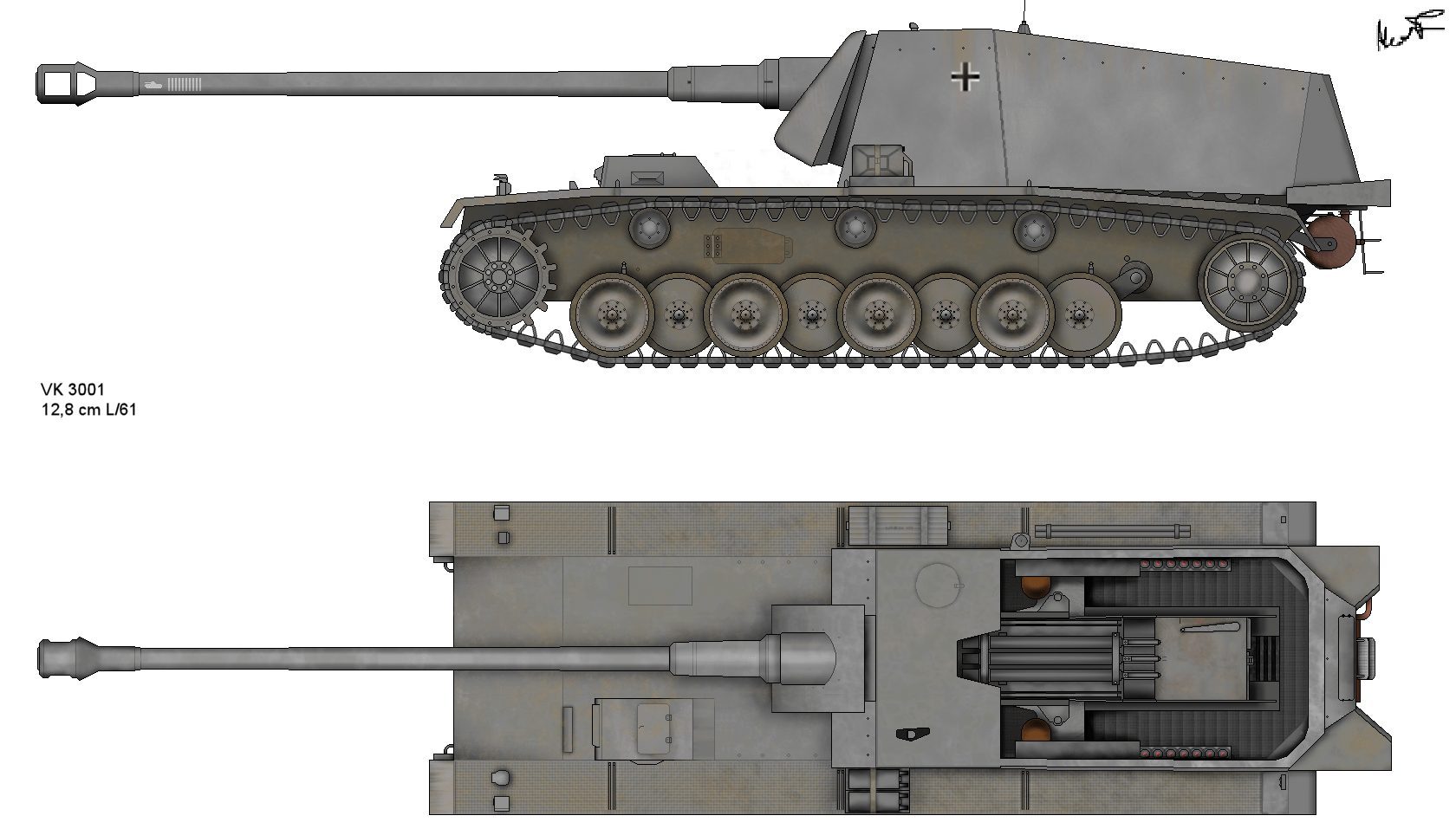
Heavy tank destroyer Sturer Emil
Heavy tank destroyer Sturer Emil12,8 cm PaK 40 L / 61 Henschel self-propelled gun on VK-3001 (Н)
However, this experimental self-propelled anti-tank gun from the Second World War was not forgotten. When Operation Barbarossa (attack on the USSR) began on June 22, 1941, hitherto invincible German soldiers met with Soviet T-34 and KV tanks. If the Russian T-34 medium tanks of the Second World War still managed to fight in half with grief, then only the Luftwaffe Flak-18 88-mm could be opposed against the Soviet KV heavy tanks. An urgent need was for a weapon capable of withstanding Soviet medium and heavy tanks. They remembered the 105-mm and 128-mm self-propelled guns. In the middle of 1941, Henshel und Sonh and Rheinmetall AG were given an order to develop a self-propelled carriage (Selbsfarhlafette) for 105-mm and 128-mm anti-tank guns. The Pz.Kpfw.IV ausf.D chassis was quickly adapted for the 105 mm gun, and the 105 mm Dicker Max self-propelled gun was born. But for the 128-mm K-44 gun, which weighed as much as 7 (seven!) Tons, the Pz.Kpfw.IV chassis was not suitable - it simply could not withstand its weight. I had to use the chassis of the Henschel experimental tank VK-3001 (H) - a tank that could become the main tank of the Reich, if not for the Pz.Kpfw.IV. But even with this chassis there was a problem - the weight of the hull could withstand a 128-mm gun, but then there was no room for the crew. To do this, 2 of the 6 existing chassis were lengthened by about two times, the number of road wheels was increased by 4 rollers, the self-propelled gun received an open cabin with a frontal armor of 45 mm.
Experimental heavy German tank destroyer "Sturer Emil" Later, at the front, the name “Sturer Emil” (Stubborn Emil) was assigned to her for frequent breakdowns. Together with 2 Dicker Max self-propelled guns, one prototype was sent to the Eastern Front as part of 521 Pz.Jag.Abt (self-propelled tank destroyer battalion), armed with Panzerjaeger 1 light self-propelled guns.
German tank destroyer "Sturer Emil" side view The main armament is the 128 mm PaK 40 L/61 cannon, which was developed in 1939 on the basis of the 128 mm FlaK 40 anti-aircraft gun. USSR in mid-1941.
Photo taken during the Second World War SAU "Stuerer Emil" Prototypes showed good results, but the project was closed, as the production of the Tiger tank was considered a priority. However, they nevertheless created two units of self-propelled guns on the chassis of the Henschel VK-3001 heavy tank prototype (which was discontinued after the development of the Tiger tank) and armed with a Rheinmetall 12,8 cm KL / 61 gun (12,8 cm Flak 40). The self-propelled gun could turn 7 ° in each direction, the aiming angles in the vertical plane ranged from -15 ° to + 10 °.
Ammunition for the gun was 18 shots. The chassis remained from the canceled VK-3001, but the hull was lengthened and an extra wheel was added to accommodate the huge cannon, which was placed on a plinth in front of the engine.
Top view of the German heavy tank destroyer "Sturer Emil" A large cabin, with an open top, was built instead of a tower. This heavy self-propelled gun, armed with 128-mm anti-aircraft guns, passed military tests in 1942. Two built German heavy self-propelled installations of the Second World War (with the personal names “Max” and “Moritz”) were used on the Eastern Front as destroyers of heavy Soviet tanks KV-1 and KV-2.
Documentary shot of the German self-propelled gun "Stubborn Emil" One of the prototypes (from the XNUMXnd Panzer Division) was destroyed in battle, and the second was captured by the Red Army in the winter of 1943 and was part of the captured weapons put on public display in 1943 and 1944.
German heavy tank destroyer "Sturer Emil" According to its characteristics, the vehicle turned out to be ambiguous - on the one hand, its 128-mm gun could pierce through any Soviet tank (in total, during the service, the crew of the self-propelled guns destroyed 31 Soviet tanks according to other sources 22), on the other hand, the chassis was too overloaded, it was a huge problem repair of the engine, since it was directly under the gun, the car was very slow, the gun had very limited turning angles, the ammunition load was only 18 rounds.
Documentary photo of the heavy German tank destroyer “Sturer Emil” For reasonable reasons, the car did not go into production. It was because of the complexity of the repair that the car was abandoned in the winter of 1942-43 during the campaign near Stalingrad, this self-propelled gun was found by Soviet soldiers and is now on display at the Kubinka Research Institute of BTT.
Documentary shot of heavy German tank destroyers "Sturer Emil"
Sources:
| ||||||||||||||||||||||||||||||||||||||||||||||

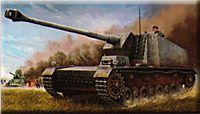 The history of this powerful self-propelled gun of the German Panzerwaffe began back in 1941, more precisely on May 25, 1941, when at a meeting in the city of Berghoff it was decided to build, as an experiment, two 105-mm and 128-mm self-propelled guns to fight "British heavy tanks" , which the Germans planned to meet during Operation Seelowe - during the planned landing on the British Isles. But, these plans for the invasion of foggy albion were abandoned, and the project was briefly closed.
The history of this powerful self-propelled gun of the German Panzerwaffe began back in 1941, more precisely on May 25, 1941, when at a meeting in the city of Berghoff it was decided to build, as an experiment, two 105-mm and 128-mm self-propelled guns to fight "British heavy tanks" , which the Germans planned to meet during Operation Seelowe - during the planned landing on the British Isles. But, these plans for the invasion of foggy albion were abandoned, and the project was briefly closed.